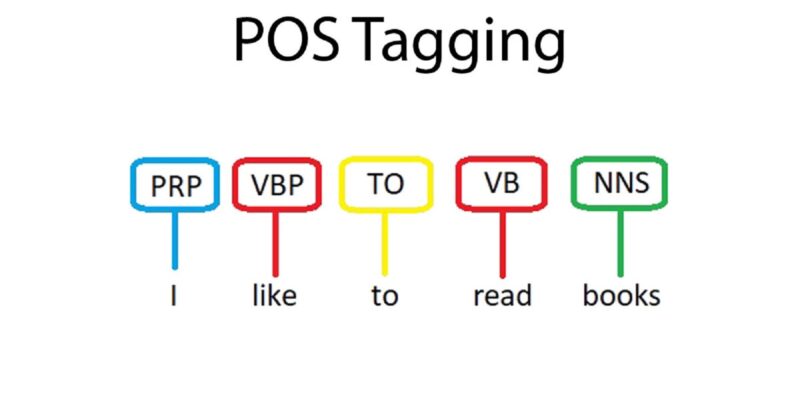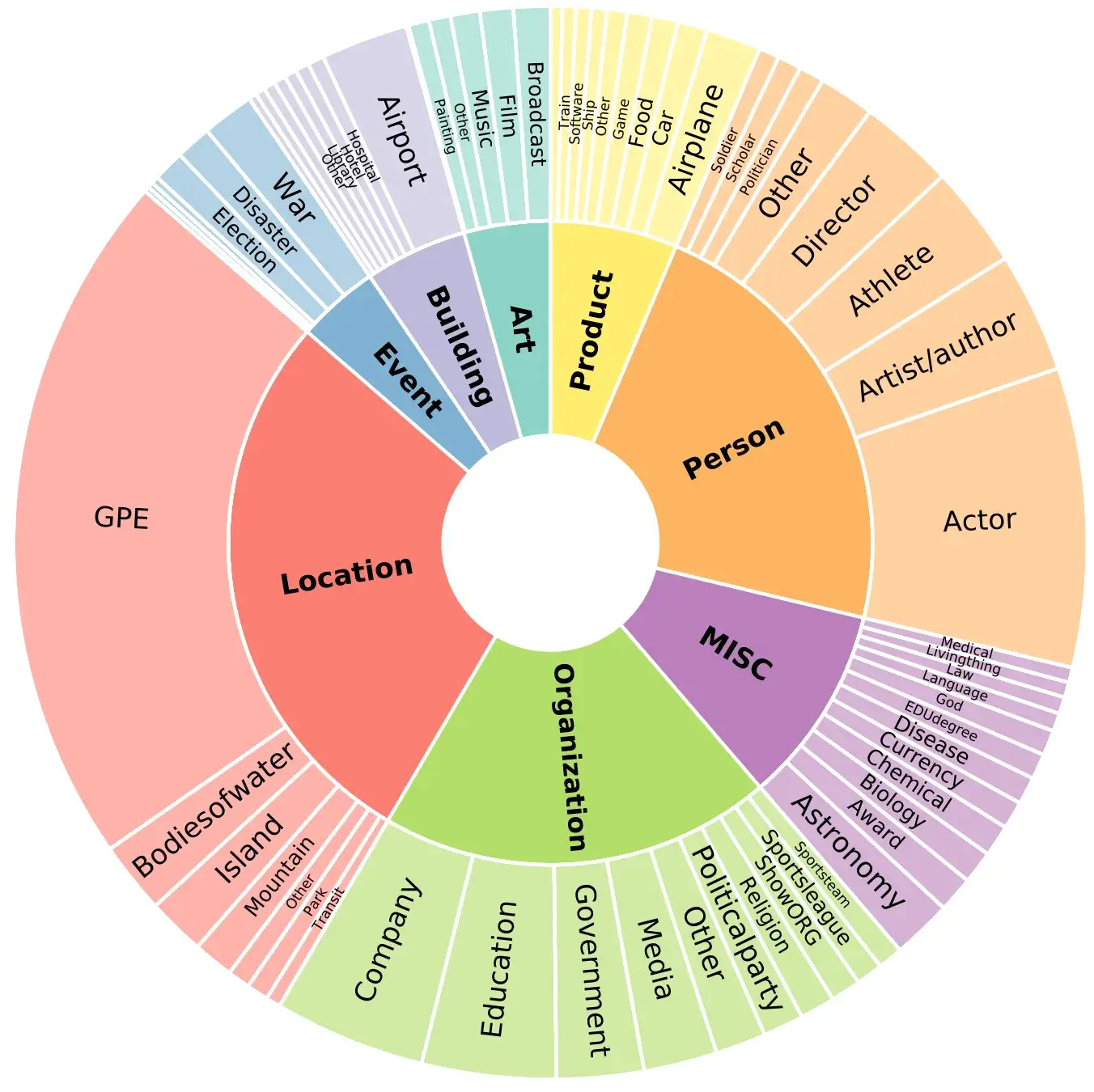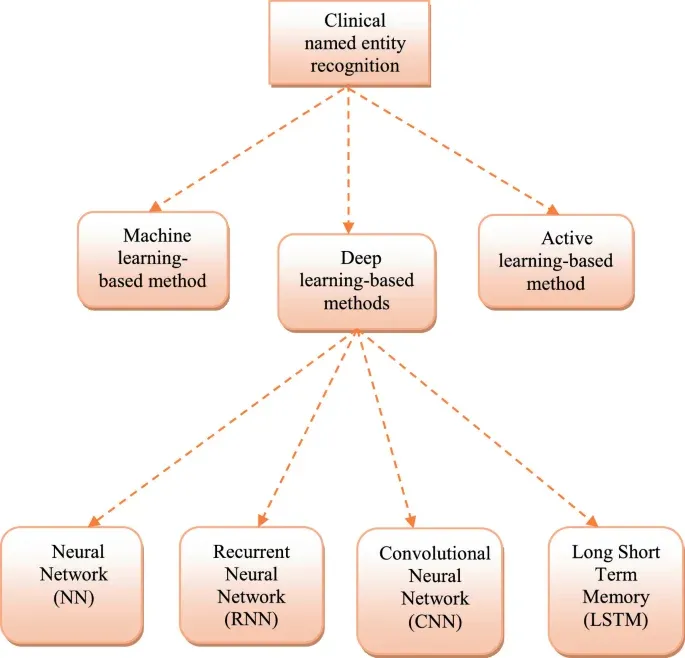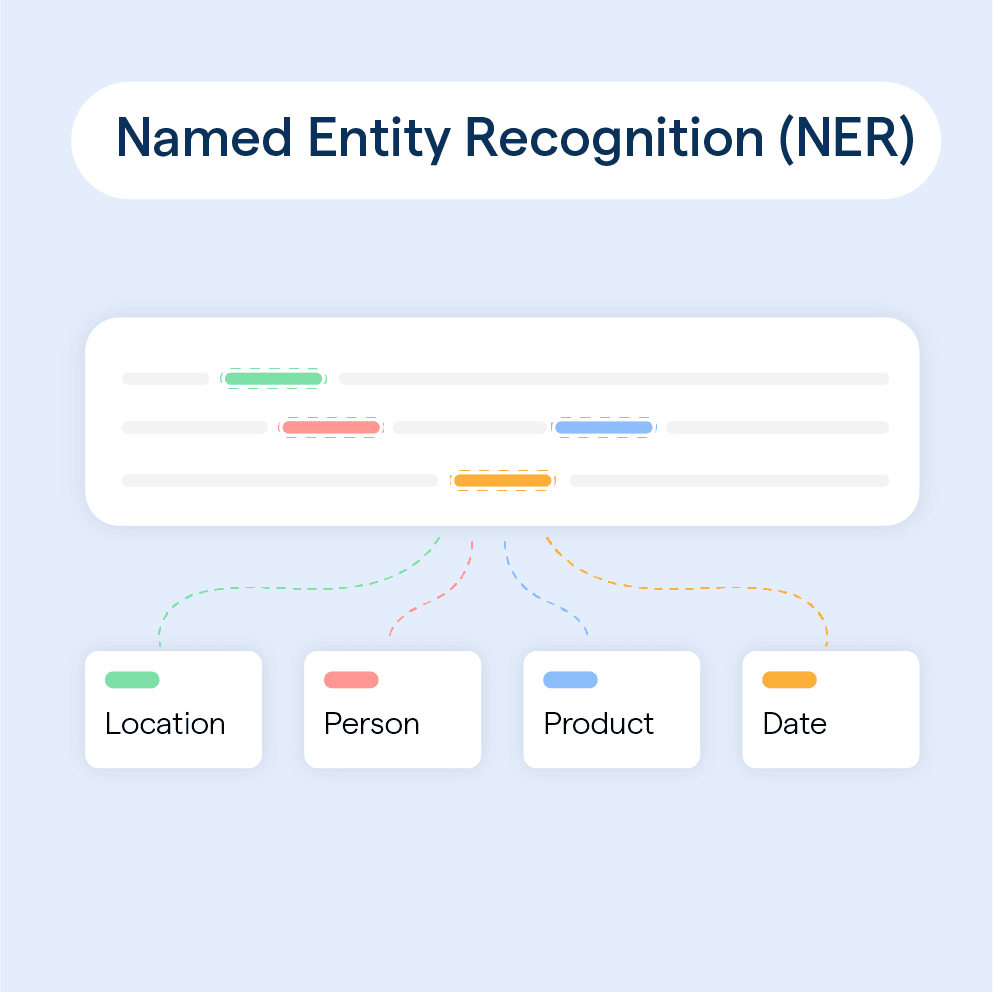What is Named Entity Recognition (NER)?
Named Entity Recognition (NER) is a fundamental technique in natural language processing (NLP) that enables the identification and extraction of specific named entities from text.
Named entities are real-world objects such as person names, organization names, locations, dates, and other important information. NER plays a vital role in various industries, including healthcare, finance, and information retrieval.
How Does Named Entity Recognition Work?
Tokenization
NER primarily starts with tokenization where the text is broken down into smaller pieces or tokens - words or punctuation.
Part-of-Speech Tagging
In this phase, each token is labeled with a part-of-speech (POS) tag (such as noun, verb, adjective, etc.) which provides context for named entity identification.

Entity Identification
Based on the POS tags, the algorithm then classifies and labels the entities in the text, e.g., Person, Location, Organization, etc.
Dependency Parsing
Finally, dependency parsing is used to analyze the grammatical structure of a sentence, helps understand the relationships between entities, providing further context.
What Can be Recognized by Named Entity Recognition?
NER can recognize various types of named entities depending on the application or domain. Some common categories include:
- Person Names: Identifying names of individuals.
- Organization Names: Recognizing names of companies, institutions, or organizations.
- Location Names: Identifying names of cities, countries, or other geographic locations.
- Date and Time Expressions: Recognizing dates, times, or duration of events.
- Monetary Values: Identifying currency symbols or expressions denoting monetary values.
NER is highly flexible, and its capability to recognize specific entities can be customized to suit specific needs.

Types of Named Entities
Named entities can be classified based on their characteristics. Some common categorizations include:
- Proper and Common Nouns: Proper nouns refer to specific names of people, places, or things (e.g., John, Paris, Google), whereas common nouns refer to general names (e.g., cat, house, car).
- Entities with Multiple Forms: Some named entities can have multiple variations or forms (e.g., abbreviations, acronyms, nicknames).
- Ontology-based Entities: Entities that are defined in a specific domain ontology (e.g., medical terms, product names).
- Temporal Entities: Entities related to time, such as dates, times, or durations.
- Numeric Entities: Entities related to numbers, such as quantities, measurements, or percentages.
Challenges in Named Entity Recognition
NER poses several challenges due to the complexity and ambiguity of natural language. Some common challenges include:
- Ambiguity in Entity Names: Certain words or phrases can have multiple possible meanings or interpretations.
- Misspelled Entity Names: Text data often contains spelling errors or variations, making it difficult to recognize named entities accurately.
- Ambiguity in Entity Types: Some words or phrases can be classified into multiple entity types, leading to uncertainty in classification.
- Variations in Entity References: Entities can be referred to using different expressions or synonyms, making their identification challenging.
- Contextual Challenges: Understanding the context of a word or phrase within a sentence or document is essential for accurate entity recognition.
Addressing these challenges requires robust NER models and techniques that can handle such complexities.
Named Entity Recognition Techniques

Several techniques are employed for Named Entity Recognition, each with its strengths and limitations. These techniques include:
- Rule-based Approaches: Using predefined patterns or rules to identify and classify named entities
. - Statistical Approaches: Utilizing statistical models to learn patterns and make predictions based on training data.
- Machine Learning Approaches: Employing machine learning algorithms, such as support vector machines (SVM) or random forests, to train models on labeled data and make predictions.
- Hybrid Approaches: Combining multiple techniques, such as rule-based and statistical approaches, to improve accuracy.
- Deep Learning Approaches: Utilizing deep learning architectures, such as recurrent neural networks (RNN) or transformer models, to learn complex patterns from large amounts of data.
The choice of technique depends on the specific requirements and characteristics of the text data.
How to Evaluate Named Entity Recognition Systems?
Here's how you can evaluate Named Entity Recognition System:
Precision and Recall
For evaluating NER systems, two key metrics are used - precision (the accuracy of named entities identified) and recall (the extent of true named entities being detected).
F1-Score
F1-Score combines precision and recall to provide a summarized measure of a NER system's performance. It is essentially the harmonic mean of precision and recall, serving as a single metric for comparison.
Entity Types
Another crucial aspect of evaluation is identifying the types of named entities recognized by the NER system. The system should accurately categorize named entities whether they are persons, organizations, locations, or any other entity type.
Systematic Errors
Identify and analyze systematic errors in the NER system, such as incorrect tagging or missed entities. Understanding these larger patterns of error can guide improvements and refinements.
Real-World Application
Lastly, evaluate the NER system's performance in real-world scenarios. Context matters, and the system should demonstrate robust recognition capabilities under varying data and use-cases.
Challenges and Limitations of Named Entity Recognition
While Named Entity Recognition is a powerful technique, it comes with certain challenges and limitations. These include:
- Language-Specific Challenges: NER performance can vary across different languages due to differences in grammar, syntax, and entity naming patterns.
- Out-of-Vocabulary Entities: NER models may struggle to recognize entities that are not part of their training data, leading to potential errors.
- Scalability and Performance Issues: As the size of the text data increases, the scalability and computational efficiency of NER systems can become a challenge.
- Privacy Concerns with Sensitive Data: NER systems need to handle personal or sensitive information carefully to ensure data privacy and compliance with regulations.
- Ethical Considerations in NER Applications: Proper precautions must be taken to avoid biased or discriminatory results when applying NER to sensitive topics or domains.
Continual advancements and research are necessary to address these challenges effectively and responsibly.
Frequently Asked Questions (FAQs)
How does Named Entity Recognition Work?
NER works by first tokenizing the text into individual words, then applying part-of-speech tagging to assign grammatical tags to each word, followed by entity recognition, where algorithms use patterns, rules, or machine learning techniques to detect and classify named entities based on contextual information.
What are the Applications of Named Entity Recognition?
NER plays a crucial role in various industries such as healthcare, finance, and information retrieval.
It enhances information extraction, provides valuable insights, improves text analysis and understanding, and facilitates advanced data analysis and knowledge discovery.
What are the Challenges in Named Entity Recognition?
NER faces challenges such as ambiguity in entity names, misspelled entity names, uncertainty in entity types, variations in entity references, and contextual challenges.
What are the Techniques Used for Named Entity Recognition?
Named Entity Recognition techniques include rule-based approaches, statistical approaches, machine learning approaches, hybrid approaches, and deep learning approaches.
The choice of technique depends on the specific requirements and characteristics of the text data.

